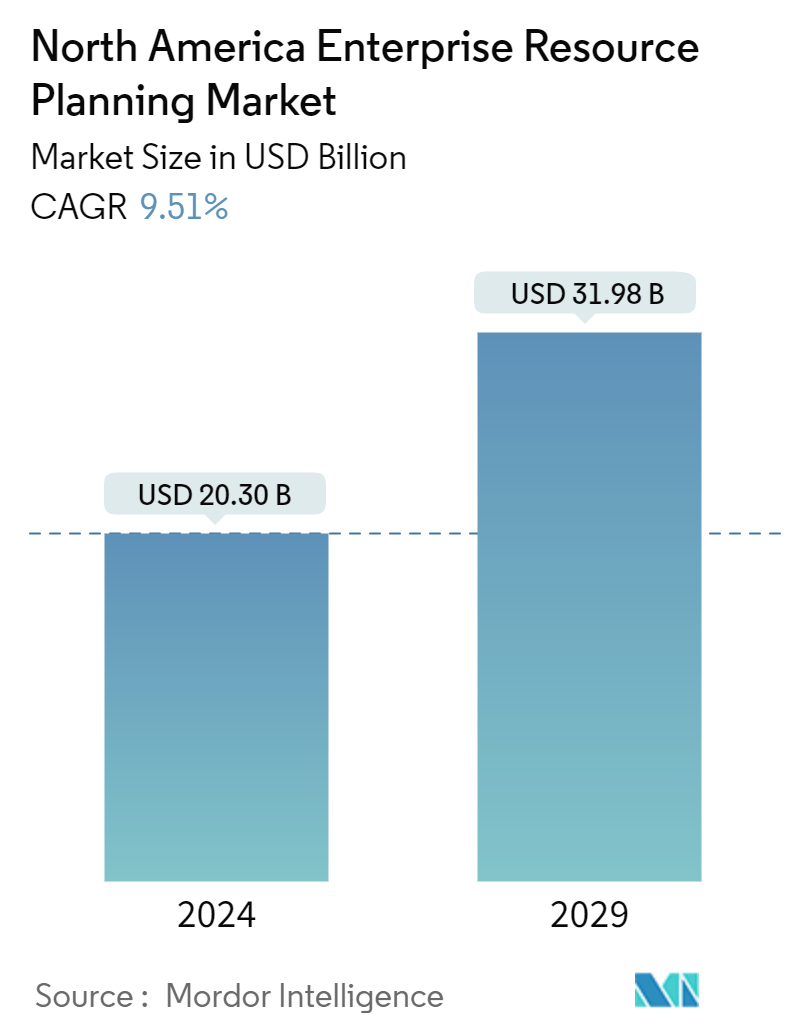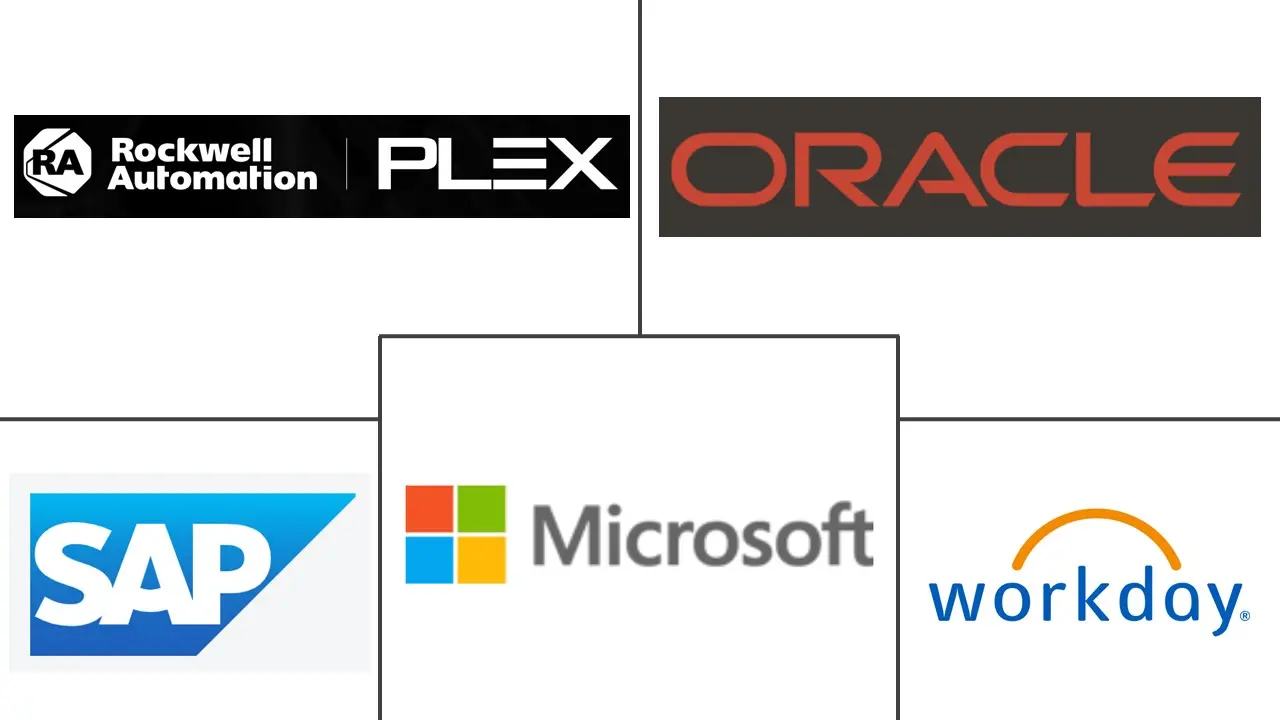Market Size of North America Enterprise Resource Planning Industry

| Study Period | 2019 - 2029 |
| Base Year For Estimation | 2023 |
| Market Size (2024) | USD 20.30 Billion |
| Market Size (2029) | USD 31.98 Billion |
| CAGR (2024 - 2029) | 9.51 % |
| Market Concentration | Low |
Major Players
*Disclaimer: Major Players sorted in no particular order |
North America Enterprise Resource Planning Market Analysis
The North America Enterprise Resource Planning Market size is estimated at USD 20.30 billion in 2024, and is expected to reach USD 31.98 billion by 2029, growing at a CAGR of 9.51% during the forecast period (2024-2029).
Enterprise Resource Planning (ERP) systems play a pivotal role in North America, supporting operational and strategic functions across various industries such as retail, manufacturing, and financial services. These systems are crucial for enhancing productivity, streamlining processes, and improving decision-making. Over the years, ERP solutions have evolved by integrating advanced technologies like cloud computing, artificial intelligence (AI), and mobile functionalities to offer more flexible and scalable systems. With the digital transformation of businesses, ERP adoption has surged, particularly among small and medium-sized businesses (SMBs), seeking cost-effective solutions with high returns on investment (ROI).
Technological Evolution and ERP Adoption
- Advanced technologies drive ERP software growth: Cloud computing, AI, and mobile functionalities have reshaped ERP solutions, making them more adaptable and accessible. Businesses benefit from these innovations by adopting flexible and scalable ERP systems that reduce costs and improve efficiency. ERP system implementation strategies are now highly tailored to specific industries such as education, defense, and telecom, addressing their unique challenges while enhancing the overall user experience and data security.
- ERP adoption rates among SMBs: The shift towards digital operations has accelerated ERP adoption, particularly among SMBs that require affordable yet robust systems to compete in the evolving marketplace. As these businesses digitize, ERP software growth is supported by innovations that promise high ROI while minimizing upfront infrastructure investments. This trend underscores ERP software’s critical role in business growth across various sectors.
Cloud ERP Solutions and Market Dynamics
- Cloud ERP systems increase flexibility and scalability: Cloud-based ERP solutions have become a game-changer for businesses, providing greater agility and eliminating the need for expensive on-premise infrastructure. These platforms also offer faster deployment, reduced maintenance costs, and the ability to scale systems as needed. Cloud ERP solutions are particularly beneficial for sectors experiencing fluctuating demand, such as retail and logistics, as they enable businesses to expand or contract their systems efficiently.
- Market shift towards hybrid ERP deployments: While cloud ERP adoption has surged, hybrid systems that combine on-premise and cloud functionalities are gaining traction. These systems offer the best of both worlds, providing cost-effective, scalable cloud solutions while maintaining the control and security associated with on-premise systems. This model has been especially favored by large enterprises with complex, global operations.
Key ERP Vendors and Competitive Landscape
- Leading ERP vendors dominate the market: The North American ERP market is highly competitive, with major players like SAP SE, Oracle Corporation, and Microsoft Corporation leading the pack. These vendors offer comprehensive solutions that integrate core business functions such as finance, human resources, and supply chain management into unified platforms. Their ability to consistently innovate with cutting-edge features ensures their continued dominance in the ERP market.
- Fragmented market with specialized vendors: Despite the dominance of global giants, the market remains fragmented, with numerous mid-sized and smaller ERP vendors offering industry-specific solutions. This fragmentation ensures a diverse range of offerings tailored to the unique needs of businesses across different sectors, further driving ERP software market growth in North America.
Rising Demand for Real-Time Decision Making
- Real-time ERP systems enhance decision-making: In today’s fast-paced business environment, real-time data analytics and decision-making capabilities are critical for staying competitive. ERP systems equipped with real-time dashboards, analytics, and data visualization tools provide businesses with the ability to access up-to-date information, facilitating swift and informed decisions. These features are especially valuable in industries like manufacturing, retail, and logistics, where timely insights can significantly impact supply chain management and inventory control.
- Enhanced customer relationship management (CRM): Real-time ERP systems not only improve internal decision-making but also enhance CRM by giving businesses a comprehensive view of customer interactions and behaviors. By leveraging real-time insights, companies can anticipate customer needs, personalize services, and boost customer satisfaction. This capability further strengthens the position of ERP systems as indispensable tools for modern enterprises.
Cloud-Based ERP Solutions Gain Momentum
- Cost-effectiveness drives cloud ERP adoption: The rapid shift towards cloud ERP solutions in North America is largely due to their lower upfront costs and reduced maintenance requirements compared to traditional on-premise systems. Cloud ERP is especially appealing to SMBs, enabling them to access advanced functionalities without heavy investments in IT infrastructure. The subscription-based pricing models also make these solutions more accessible, further driving their adoption.
- Security and compliance enhancements: As businesses transition to cloud ERP, security and compliance are top concerns. Cloud ERP vendors have made significant strides in addressing these issues through enhanced security features like encryption, multi-factor authentication, and disaster recovery services. Automatic updates and regulatory compliance tools have also alleviated data privacy concerns, increasing the confidence of businesses in adopting cloud ERP platforms.
North America Enterprise Resource Planning Industry Segmentation
Enterprise Resource Planning software can be defined, in simple terms, as a tool that helps us plan all the resources, both human and material, in any organization effectively and efficiently. Still, in reality, they are capable of managing financials, supply chains, manufacturing, operations, reporting, and human resources. They also help in decision-making through real-time data analytics and provide a consolidated view of key business metrics from operations across the business.
The North American ERP market is segmented by deployment (on-premises, cloud, hybrid), size of business (SMBs, Large enterprises), type (mobile, cloud, social, two-tier), application (retail, manufacturing, BFSI, government, telecom, defense, education & research, transport & logistics, other end-user industries), and by Country (United States, Canada, Mexico). The report offers market forecasts and size in value (USD) for all the above segments.
| By Deployment | |
| On-premise | |
| Cloud | |
| Hybrid |
| By Size of Business | |
| SMB's | |
| Large Enterprises |
| By Type | |
| Mobile | |
| Cloud | |
| Social | |
| Two-Tier |
| By Application | |
| Retail | |
| Manufacturing | |
| BFSI | |
| Government | |
| Telecom | |
| Military and Defense | |
| Education & Research | |
| Transport & Logistics | |
| Other End-user Industries |
| By Country | |
| United States | |
| Canada | |
| Mexico |
North America Enterprise Resource Planning Market Size Summary
The North America Enterprise Resource Planning (ERP) market is poised for significant growth, driven by the increasing adoption of cloud-based and hybrid systems, particularly in the United States. These systems are enhancing operational efficiency by providing integrated platforms that streamline data access across departments, reducing lead times and data duplication. Despite the overall positive outlook, challenges such as the high costs of business-specific customization and system upgrades may hinder growth, especially for small businesses with less complex departmental structures. The market is also experiencing a shift towards digital transformation, with regional vendors introducing innovative business models and offerings, such as Infor's "Three for Free" program, to attract small and mid-sized businesses.
The pandemic has accelerated the adoption of ERP systems, particularly in the healthcare sector, where cloud-based solutions have proven essential in managing patient data and supply chains. The rapid transition to cloud services is a central investment strategy for manufacturers in the region, with companies like MHN and NetSuite leveraging ERP systems to enhance operational efficiency and financial processes. The integration of artificial intelligence and machine learning into ERP systems is further driving market growth, offering improved insights and automation capabilities. The competitive landscape is characterized by significant investments in product innovation and new launches by major players, ensuring the market remains dynamic and responsive to emerging trends.
North America Enterprise Resource Planning Market Size - Table of Contents
-
1. MARKET DYNAMICS
-
1.1 Market Drivers
-
1.1.1 Increasing Focus on Real Time Decision Making
-
1.1.2 Rapid Adoption of Cloud Based ERP Solutions
-
-
1.2 Market Challenges
-
1.2.1 High Cost Associated with ERP Solutions
-
-
-
2. MARKET SEGMENTATION
-
2.1 By Deployment
-
2.1.1 On-premise
-
2.1.2 Cloud
-
2.1.3 Hybrid
-
-
2.2 By Size of Business
-
2.2.1 SMB's
-
2.2.2 Large Enterprises
-
-
2.3 By Type
-
2.3.1 Mobile
-
2.3.2 Cloud
-
2.3.3 Social
-
2.3.4 Two-Tier
-
-
2.4 By Application
-
2.4.1 Retail
-
2.4.2 Manufacturing
-
2.4.3 BFSI
-
2.4.4 Government
-
2.4.5 Telecom
-
2.4.6 Military and Defense
-
2.4.7 Education & Research
-
2.4.8 Transport & Logistics
-
2.4.9 Other End-user Industries
-
-
2.5 By Country
-
2.5.1 United States
-
2.5.2 Canada
-
2.5.3 Mexico
-
-
North America Enterprise Resource Planning Market Size FAQs
How big is the North America Enterprise Resource Planning Market?
The North America Enterprise Resource Planning Market size is expected to reach USD 20.30 billion in 2024 and grow at a CAGR of 9.51% to reach USD 31.98 billion by 2029.
What is the current North America Enterprise Resource Planning Market size?
In 2024, the North America Enterprise Resource Planning Market size is expected to reach USD 20.30 billion.

